Having a triathlon race day checklist can do wonders for any level of triathlete. The last thing you need the night before your triathlon is the worry that you don’t have all the gear.
There is just too much to pay attention to on race day for you to be checking if you have all the triathlon gear. Especially since you will be waking up pretty early for the race.
The ideal scenario is just to have a triathlon checklist and tick off everything you need on the list the night before your triathlon.
But how does one come up with an in-depth triathlon race day checklist? Well, that is where we come in. Our checklist was made thinking about what a triathlete will need in their race.
Of course, the needs of every triathlete will vary depending on their level of experience, their goals for the triathlon race and what type of triathlon they will be participating in.
Still, we feel pretty confident that this list will be very helpful for any triathlete looking for a thorough triathlon checklist.
How we decided on our Triathlon race day checklist
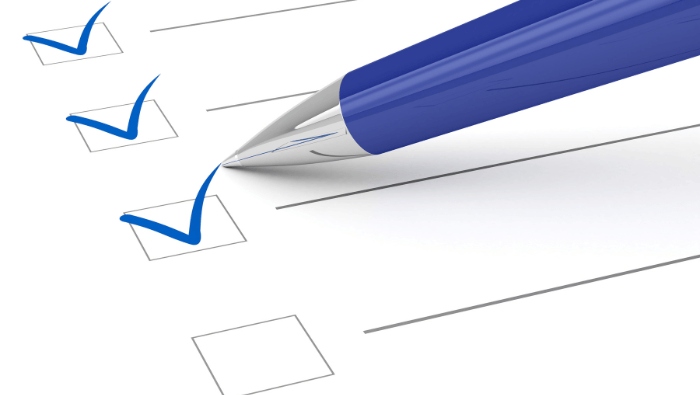
Coming up with a triathlon checklist is not as easy as “you should include this” or “you would never need that”.
As we said before, it really depends on your level of experience, goals for the triathlon and the type of triathlon race you will be participating in.
What we tried to do was create 2 lists of tri gear that you can include in a checklist. The first list is full of mandatory gear that you absolutely must have.
The second list is more of a “nice to have” gear. Still important to have, but not absolutely mandatory but will improve your race day experience and even elevate your performance.
Our checklists are more focused on standard triathlon distances like Sprint or Olympic triathlon events. At most, these lists can be useful for Half Ironman races.
Feel free to add whatever you think is necessary to our lists.
Essential gear to have on your triathlon race day checklist
When preparing for your triathlon race day, it’s crucial to have the right gear on your checklist. Here are some essential items to include:
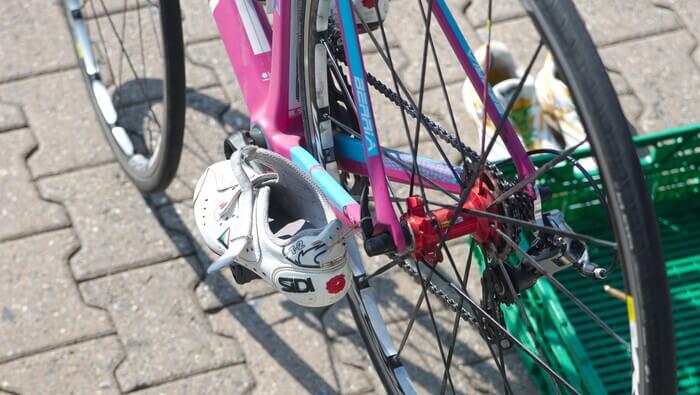
General Tri gear you will need
Triathlon clothing and shoes: We highly suggest wearing your triathlon shorts and top or shirt to the race, as it provides optimal comfort and convenience.
Make sure to wear your preferred running shoes and socks, if you usually use them. It’s advisable to have running shoes with speed laces, but remember not to introduce anything new on race day to avoid discomfort or unexpected issues.
Additionally, it’s worth noting that you will likely receive a race shirt, which can be a nice option to change into after completing the race.
I.D: Certain races may have a requirement for participants to present identification during the check-in process. It is highly recommended that you carry your identification with you.
Water: It’s always important to have water readily available during your triathlon race day. The duration of waiting for your heat to begin can vary, and it’s crucial to avoid dehydration.
Nutrition: Every triathlete has their preferences, but it’s always a good idea to have some provisions in your bag for added assurance.
Consider including items that you have already tested during your training sessions. If gel shots are more to your liking, be sure to pack a few.
Additionally, sport drink powders and capsules can be mixed with water to create a drink tailored to your athletic needs.
Phone: Ensure that you bring along your cell phone as we live in the 21st century, after all. While it’s feasible to leave it securely locked in your car during the race, transition areas are safe.
Having your cell phone in your bag can come in handy for capturing memorable moments with its camera. Moreover, your cell phone will likely be indispensable for navigating directions to the race location.
Race Packet: If you completed your race check-in the day before the event, you should have received your race packet. However, if you plan to check-in on the morning of the race, you can disregard this information.
Transition bags: By now, you’ve likely realized that gathering all these items is best done by packing them in a bag. Some triathletes opt for dedicated transition bags designed for the sport, while others simply repurpose their gym bags.
The choice ultimately depends on your budget and priorities.
Triathlon gear for Swimming
Wetsuit: If a wetsuit is necessary for your triathlon, make sure to include it on your checklist. However, it’s important to note that wetsuits are not mandatory for most races, and there may be restrictions if the water temperature is too warm.
If you do plan on racing with a wetsuit, it’s recommended to have prior experience using it before race day.
A wetsuit provides buoyancy and insulation, allowing you to swim faster and stay warm in open water. Look for a well-fitting suit with good flexibility and range of motion.
Swim goggles: Goggles are vital for clear vision underwater. Choose a pair that fits well, doesn’t fog easily, and provides UV protection.
We highly recommend investing in a fresh pair of swim goggles for your race day. Opting for new goggles will significantly minimize glare from the sun, enhancing your visibility in the water.
However, it’s crucial to purchase a model that you have previously used and tested to ensure a comfortable fit and proper functionality.
Swim cap: A swim cap reduces drag and helps keep your hair out of your face. Opt for a silicone or latex cap that fits snugly and is comfortable to wear.
Timing chip: Most triathlons provide a timing chip that you wear on your ankle. Ensure it’s securely fastened before entering the water to accurately track your time.
Triathlon gear for Cycling
Triathlon bike: People have actually forgotten their bikes before heading to a triathlon race.
To avoid any unwelcome surprises, we highly recommend taking a quick test ride around the block the night before. This will allow you to spot and address any issues, such as a loose seat stem or a leaky tire, before race day.
A specialized triathlon bike or a road bike with appropriate modifications is essential. Look for a lightweight, aerodynamic frame with efficient gearing and comfortable geometry.
Don’t forget to pump your tires to the desired pressure before you leave home.
Bike rack or carrier: If tossing your bike into the back of your car isn’t an option, a reliable bike rack or carrier becomes essential for transportation.
Ensure that you can easily locate your bike rack and have all its components ready for race-day morning. Countless athletes have experienced frantic moments when they couldn’t find a small but crucial part necessary for the rack to work correctly.
So, be proactive, organize your gear, and eliminate unnecessary stress on race day. Your preparedness will make for a smoother and more enjoyable experience when it matters most.
Helmet: Wearing a bike helmet during the ride is a mandatory requirement for any race that follows the guidelines set by USAT (which is the case for the majority of races). It is not a matter of choice; rather, it is a wise decision that prioritizes safety.
Invest in a well-ventilated, aerodynamic helmet that meets the relevant safety standards.
Cycling shoes: Don’t forget your bike shoes, they are probably the most forgotten item. Clip-in cycling shoes improve pedaling efficiency.
Choose shoes that provide a secure fit, good ventilation, and compatibility with your bike’s pedal system.
Sunglasses: Protect your eyes from sun glare, wind, debris and bugs with sport-specific sunglasses. Look for lightweight frames with interchangeable lenses for different light conditions.
To make sure you remember to wear them, keep your sunglasses stored inside your bike helmet.
Cycling jersey and shorts: Wear moisture-wicking, padded cycling shorts and a breathable jersey for comfort during the bike leg.
Cycling gloves: Padded gloves enhance grip, absorb shock, and protect your hands during long rides. Choose gloves that fit well and provide ventilation.
Water bottles and hydration system: Stay hydrated throughout the bike leg with a reliable water bottle or hydration system. Ensure they are easily accessible and securely mounted on your bike.
Spare tube and tire changing kit: Be prepared and carry the same supplies you typically bring on a regular ride. So, if you do get a flat, take a few minutes to fix it and then keep riding!
There’s no need to bring your entire gear kit; simply pack what you would take along on a solid training ride.
Triathlon gear for Running
Running shoes: Invest in a pair of running shoes that provide adequate support, cushioning, and a good fit for your feet. Choose models suitable for your running style.
Running apparel: Wear moisture-wicking, lightweight clothing for the run leg. Look for breathable fabrics and consider compression gear to aid muscle recovery.
Race belt: A race belt allows you to easily attach your race number without the need for pins. Look for an adjustable and comfortable belt that holds your number securely.
Visor or cap: Protect yourself from the sun and keep sweat out of your eyes with a visor or cap. Choose one that is lightweight, breathable, and provides a comfortable fit.
Additional triathlon gear that can be included on your triathlon race day checklist
In addition to the essential gear mentioned earlier, there are a few more items you may want to consider including on your triathlon race day checklist:
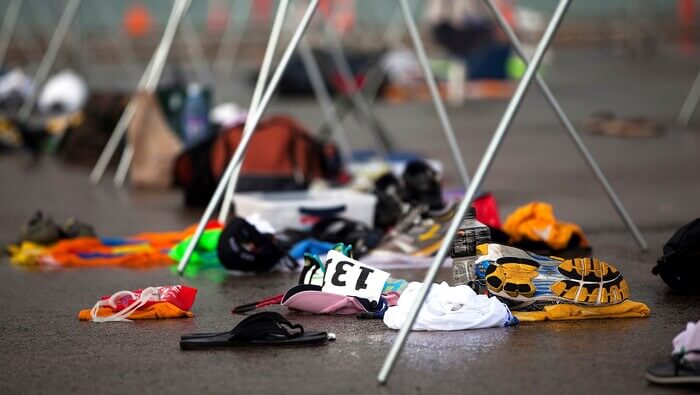
Towel: Pack a small towel to dry off and wipe down after the swim. You can also use it to lay out your gear in the transition area. Get a towel with bright colors as you can use it as a marker to spot your transition area.
Recovery tools: Consider bringing a foam roller, massage stick, or compression boots for post-race recovery. These tools can help alleviate muscle soreness and aid in faster recovery.
Medication: If you’re depending on a daily medication, it’s crucial to remember to take it before you hit the road. It’s easy to overlook this when you’re starting your drive at the crack of dawn or even earlier.
The adrenaline and anticipation of race day can disrupt our usual routines, and the last thing we want is for you to miss an important dose.
So, be mindful and prioritize your health, ensuring you stay on track with your medication even amidst all the excitement.
Spare inner tubes and repair kit: Carry spare inner tubes, a tire lever, and a mini bike pump in case of flat tires. Familiarize yourself with basic bike repair techniques to handle minor issues.
Sunscreen: Protect your skin from harmful UV rays with a sweat-resistant sunscreen. Apply it before the race and consider using a sunscreen stick for easy reapplication during transitions.
Spare race kit: It’s wise to have a backup race kit in case of unforeseen circumstances such as a ripped tri suit or misplaced gear. Keep a spare set of essentials ready in your transition bag.
A GPS watch: A popular choice among triathletes is to opt for a dedicated triathlon watch that serves them well throughout all three race segments.
These specialized watches are designed to withstand the demands of swimming, cycling, and running.
Some plastic bags: In case it starts pouring while you’re swimming, those old grocery store plastic bags can surprisingly come in handy! They do a great job of keeping your transition gear dry until you’re ready to use it.
Race belt: Attaching your race number to your shirt is a straightforward option (most races offer pins for this purpose). However, using a race belt is a more seamless and cost-effective alternative. In fact, they are quite affordable.
Bug spray: During certain races, it’s not uncommon to encounter bugs or water-borne gnats that can become bothersome and lead to Swimmers Itch. It’s a wise precaution to include bug spray in your gear, as it will effectively repel these nuisances and help you avoid any discomfort.
An anti-chafing product: As the name says, it is an anti-chafing product. This is critical for longer races. Another use for it is to apply it to your ankles before the swim. This will help the wetsuit come off more easily.
Some triathlon race day tips from a fellow triathlete
As a triathlete, I’ve encountered various challenges and learned valuable lessons along the way. One essential tip is to practice using your gear during training to ensure comfort and familiarity.
This includes swimming with your wetsuit, cycling with clip-in shoes, and running in your race-day shoes.
Proper organization is crucial for a smooth race day. Lay out your gear the night before and double-check that everything is in its place. Create a checklist to avoid forgetting any crucial items.
During transitions, aim for efficiency. Practice quick changes between stages to minimize time loss. Lay out your gear in a logical order, prioritize what you need, and discard any unnecessary items.
Rise and shine bright and early, ensuring you have ample time to grab a bite to eat 3-4 hours before the race kicks off. Stick to foods that are familiar and easy on the stomach for optimal digestion.
As the start time draws near, it’s a good idea to gradually cut back on your fluid intake, stopping about 2 hours prior to the race. However, keep sipping water as needed to stay hydrated.
Don’t worry, it’s completely normal for everyone to make a quick pit stop to relieve themselves, even if it means peeing in their wetsuit!
Getting to the race venue ahead of time is key to securing a prime spot in the transition area. Aim for an end spot on the rack that’s conveniently located near the bike in/out area.
Make a mental note of distinctive landmarks to easily locate your designated rack.
Slip into your wetsuit and take a plunge into the water for a thorough swim warm-up around 15-20 minutes before your scheduled start time. Position yourself near the start line about 5-10 minutes ahead of the race kick-off.
Always remember that the countless hours you’ve dedicated to training have led you to this very moment.
Trust in your preparation, give it your all, and above all, cherish the experience and savor the thrill of the race!
Conclusion
In conclusion, having a comprehensive triathlon race day checklist is essential for every triathlete. The last thing you want is to be stressed about missing important gear on the day of your race.
By using our carefully crafted triathlon checklist, you can rest easy knowing that you have everything you need for a successful race. Whether you’re a beginner or an experienced triathlete, our checklist is designed to cater to various levels of experience and goals.
So, make sure to review and tick off all the items on our triathlon race day checklist the night before your race, and you’ll be fully prepared to conquer the challenges that lie ahead. Happy racing!

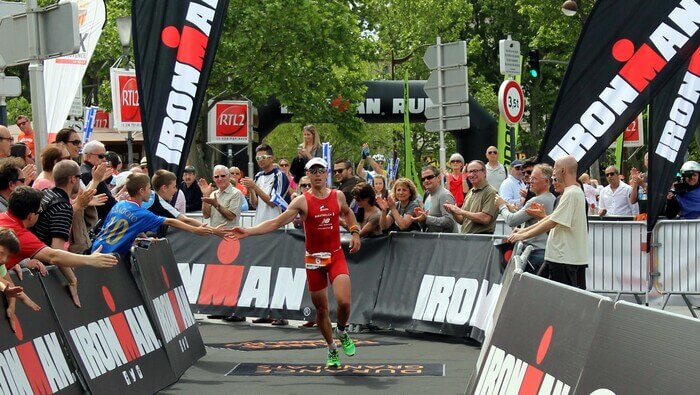
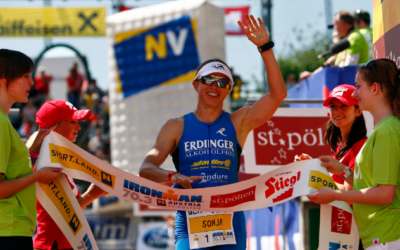
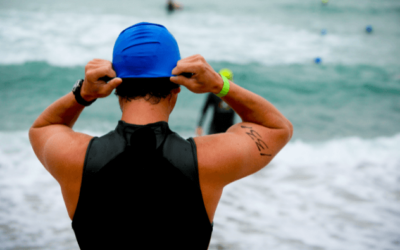

0 Comments